Overview
The article presents critical insights into renewable energy and storage modeling, highlighting their essential role in enhancing project efficiency. It asserts that advanced modeling techniques, in conjunction with robust policy frameworks and technological innovations, are vital for optimizing investments and ensuring the successful integration of renewable resources into the energy landscape. By addressing the complexities of land acquisition, including legal and regulatory challenges, the article underscores the importance of these insights in navigating the evolving energy sector.
Introduction
In a world increasingly reliant on sustainable energy sources, the significance of effective land acquisition and energy storage solutions is paramount. The renewable energy sector is evolving, presenting stakeholders with the challenge of navigating complex landscapes that demand innovative strategies and comprehensive planning. This article explores the multifaceted approaches organizations like Harbinger Land employ to facilitate land acquisition for renewable projects. Additionally, it examines cutting-edge advancements in energy storage modeling.
As we delve into the integration of artificial intelligence and the development of long-duration energy storage systems, it becomes evident that the future of renewable energy management is poised for transformation. By examining these critical elements, we highlight how strategic planning and technological innovations can drive efficiency, sustainability, and successful project execution in the renewable energy arena.
What challenges do you face in land acquisition? Understanding the legal and regulatory complexities is essential for effective project execution. By showcasing the benefits of innovative solutions, we aim to illustrate how organizations can overcome these hurdles. The discussion emphasizes the necessity of effective strategies in navigating the intricacies of land acquisition and energy storage, ultimately paving the way for a more sustainable future.
Harbinger Land | Comprehensive Solutions for Land Acquisition in Renewable Energy Projects
Harbinger Land stands out as a leader in providing customized land acquisition solutions that are essential for sustainable power projects. Their extensive services include site and right-of-way acquisition, utilizing advanced GIS modeling to create efficient easements that save clients both time and money. Moreover, Harbinger Land digitizes property data through effective document imaging solutions, deploying imaging agents to courthouses or obtaining documents via records requests. This enables title agents to conduct title research and leasing in a cost-effective manner, which is crucial for compliance with legal and regulatory standards.
As the landscape of sustainable resources evolves, the demand for effective land acquisition has intensified. This underscores the importance of strategic planning and implementation. Successful site acquisition efforts in this sector have resulted in expedited project timelines and improved stakeholder satisfaction, showcasing the effectiveness of Harbinger Land's approach.
Furthermore, the case study titled 'Individual Responsibility in Sustainability' illustrates that every action contributes to broader sustainability objectives, highlighting the critical role of land acquisition in sustainable projects. As Harbinger Land remains at the forefront of this dynamic industry, they continuously adapt their solutions to meet the changing needs of their clients, ensuring timely and precise services tailored to specific project requirements.
Energy Storage Modeling: Enhancing Efficiency in Renewable Energy Systems
Power retention modeling stands as a pivotal element in enhancing the effectiveness of sustainable power systems. By simulating various scenarios, stakeholders can accurately predict the performance of power retention solutions under diverse conditions. This predictive capability not only facilitates improved planning but also ensures a seamless integration with sustainable sources, thereby guaranteeing that power supply meets demand efficiently. Enhancing the size and type of solutions not only boosts reliability but also contributes significantly to the overall efficiency of power systems.
As the sustainable power retention market is poised for remarkable growth—from $125.42 billion in 2024 to $169 billion in 2025—advancements in power retention modeling are becoming increasingly essential. These innovations are driven by technological advancements and a heightened focus on sustainability, establishing power retention modeling as a critical component in project planning and implementation for sustainable initiatives.
Moreover, as highlighted by Precedence Research, the ongoing transition of utilities toward reducing capacity and transmission expenses underscores the necessity for power retention as a preferred solution. The case study on Renewable Energy Capacity Growth illustrates how renewable energy + storage modeling effectively captures and retains power from sustainable sources, thereby enhancing the reliability and efficiency of power networks. Additionally, the market dynamics, which include revenues from services like power preservation as a service (ESaaS) and sales of battery power reserve units, emphasize the financial implications of efficient power management modeling. In light of these factors, it is clear that investing in power retention modeling is not merely beneficial; it is imperative for stakeholders aiming to navigate the complexities of the evolving energy landscape.

AI-Powered Energy Storage Modeling: Transforming Renewable Energy Management
AI-driven power retention modeling is fundamentally transforming the management of renewable energy + storage modeling systems. By harnessing sophisticated machine learning algorithms, these models analyze extensive datasets to accurately predict production and consumption trends. This enhanced predictive capability facilitates smarter resource management, optimizing the timing for storage and release back to the grid. Consequently, overall efficiency and reliability are significantly improved.
The Asia Pacific region exemplifies this trend, with the AI in sustainable power market projected to surge from $4.8 billion in 2023 to $44 billion by 2032, driven by escalating electricity demand and the integration of AI technologies in power generation.
As Olena Zherebetska, Content Manager, articulates, "By examining data and automating processes, AI facilitates more intelligent decision-making, enhanced grid integration, and improved overall performance of sustainable power solutions."
Such advancements underscore the critical role of AI in enhancing the efficiency of renewable energy + storage modeling frameworks, thus enabling utilities to make data-informed decisions that align with evolving power requirements.
Solar Energy and Storage Integration: Maximizing Renewable Resource Utilization
Integrating solar power with storage solutions is crucial for maximizing the efficiency of renewable energy + storage modeling. By capturing surplus energy generated during peak sunlight hours, solar systems can deliver a consistent power supply even when production wanes. This integration not only boosts the reliability of solar energy but also facilitates improved resource management. Consequently, it diminishes reliance on fossil fuels, paving the way for a more sustainable future.
Consider the challenges faced in harnessing renewable energy effectively. The complexities surrounding land acquisition, coupled with legal and regulatory hurdles, can pose significant obstacles. However, the integration of solar power with renewable energy + storage modeling addresses these issues head-on. It allows for a seamless transition to renewable energy, ensuring that energy demands are met without compromising on sustainability.
The benefits of this integration are clear. It enhances energy reliability, promotes better resource management, and contributes to environmental sustainability. As we move towards a future that prioritizes renewable energy, embracing solar power along with renewable energy + storage modeling becomes not just beneficial, but essential.
In light of these advantages, it is imperative to consider how your organization can leverage these technologies. Are you ready to take action towards a more sustainable energy future? The time to integrate solar power with storage solutions is now.
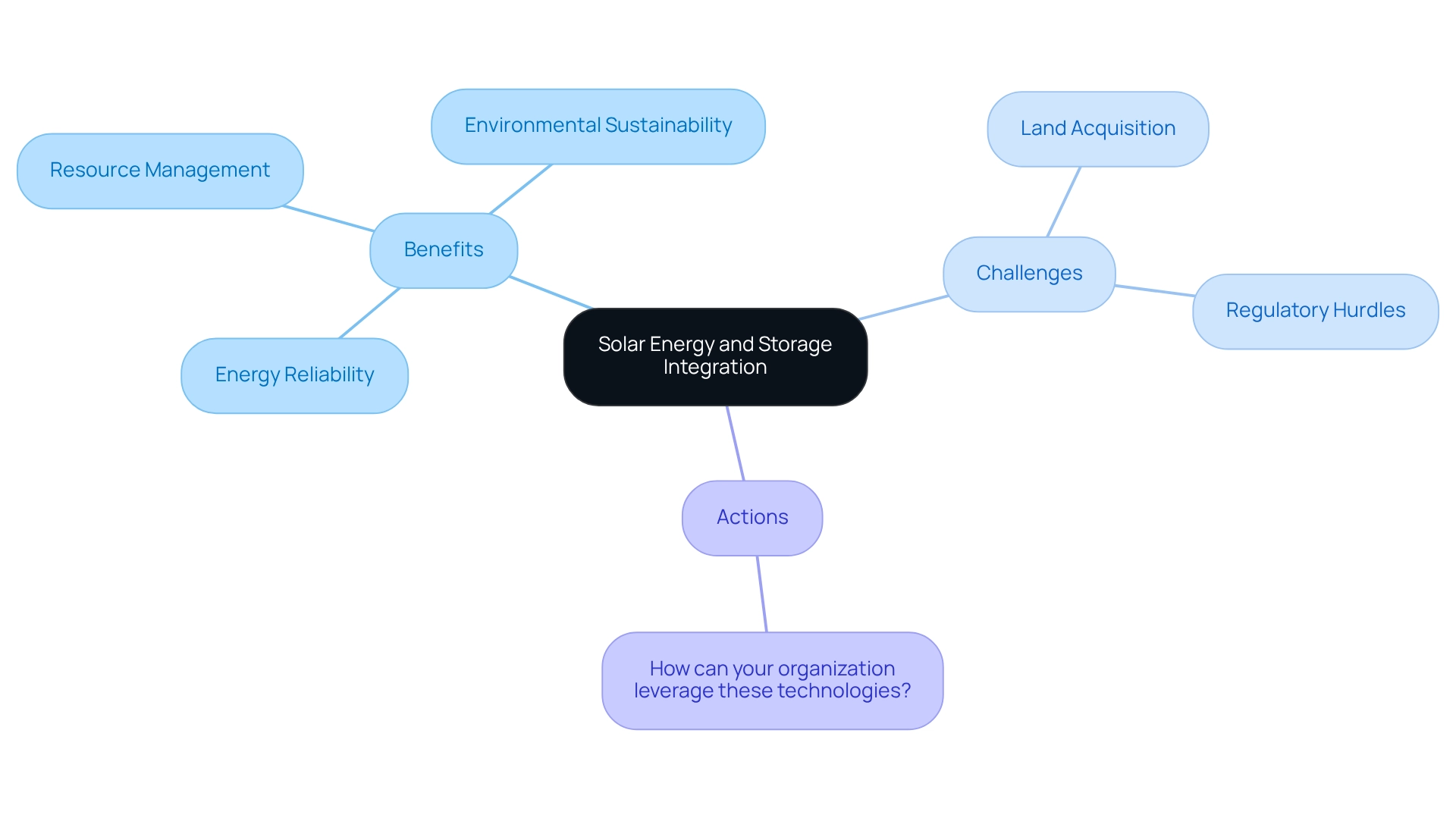
Long-Duration Energy Storage: Overcoming Challenges for Sustainable Energy Supply
Long-duration power preservation (LDES) is essential in renewable energy + storage modeling to tackle the challenges associated with the intermittency of renewable energy sources, including solar and wind. By enabling the storage of energy over extended periods, LDES solutions ensure a dependable supply during low production times, which is vital for meeting sustainability goals and strengthening grid resilience.
With the rising demand for renewable energy, the anticipated growth of large-scale battery capacity—from 1 GW in 2019 to a projected 98 GW by 2030—underscores the increasing importance of renewable energy + storage modeling in future energy systems. However, the integration of LDES is fraught with challenges. Current long-duration power reserve solutions face technological hurdles, such as the need for advanced materials that can withstand repeated charge and discharge cycles. Regulatory challenges also exist, necessitating updated policies to facilitate the use of repurposed batteries in power reserve systems.
For instance, repurposing retired electric vehicle (EV) batteries, which can retain up to 80% of their usable capacity post-retirement, presents a viable avenue for grid-scale power management. Initial tests indicate promising potential, suggesting that these second-life batteries could significantly enhance power storage solutions, and addressing the challenges through renewable energy + storage modeling is crucial for widespread adoption.
As noted by specialists in the field, efficient LDES frameworks can deliver approximately 10,000 cycles with minimal degradation over time, underscoring their viability as long-term power solutions. Successful implementations of LDES, particularly those utilizing repurposed EV batteries, not only bolster power reliability but also contribute significantly to sustainability efforts, making renewable energy + storage modeling a focal point for utilities adapting to the evolving energy landscape.
For Directors of Land Acquisition, understanding the implications of LDES on land use and acquisition strategies is crucial, as these systems require substantial space and infrastructure, influencing project planning and execution.
Modeling Techniques for Optimizing Energy Storage Systems in Renewable Energy
A range of modeling methods is crucial for enhancing power retention solutions in sustainable applications. Simulation modeling, optimization algorithms, and scenario analysis empower stakeholders to evaluate the performance of various arrangement configurations under different conditions. For instance, dynamic programming, as emphasized in the case study 'Dynamic Programming in Residential BESS Optimization,' has proven effective in optimizing residential battery solutions (BESS), particularly when integrated with renewable power sources. This approach not only enhances operational efficiency but also results in significant cost savings for consumers.
The correlation between battery cycle life and depth of discharge is essential, with figures such as 3278, 12823, 14122, and 5112 illustrating the importance of these metrics in enhancing power retention. Specifically, these values demonstrate how varying depths of discharge can impact the lifespan and efficiency of battery technologies, aiding stakeholders in making informed choices about power deployment. By leveraging these modeling techniques, stakeholders can identify the most effective strategies for deploying renewable energy and storage modeling, ultimately improving the overall efficiency and reliability of sustainable power solutions.
As noted by energy analyst Meicheng Li, "Stochastic Optimization Method for Power Reserve System Configuration Considering Self-Regulation of the State of Charge" underscores the importance of advanced optimization techniques in refining power reserve setups. A practical takeaway for stakeholders is to consider adopting dynamic programming and stochastic optimization techniques to boost the efficiency of their power retention solutions.
Recent advancements in power conversion technologies, driven by the increasing adoption of renewable energy and storage modeling, further emphasize the necessity for robust modeling methods to ensure reliability and performance.
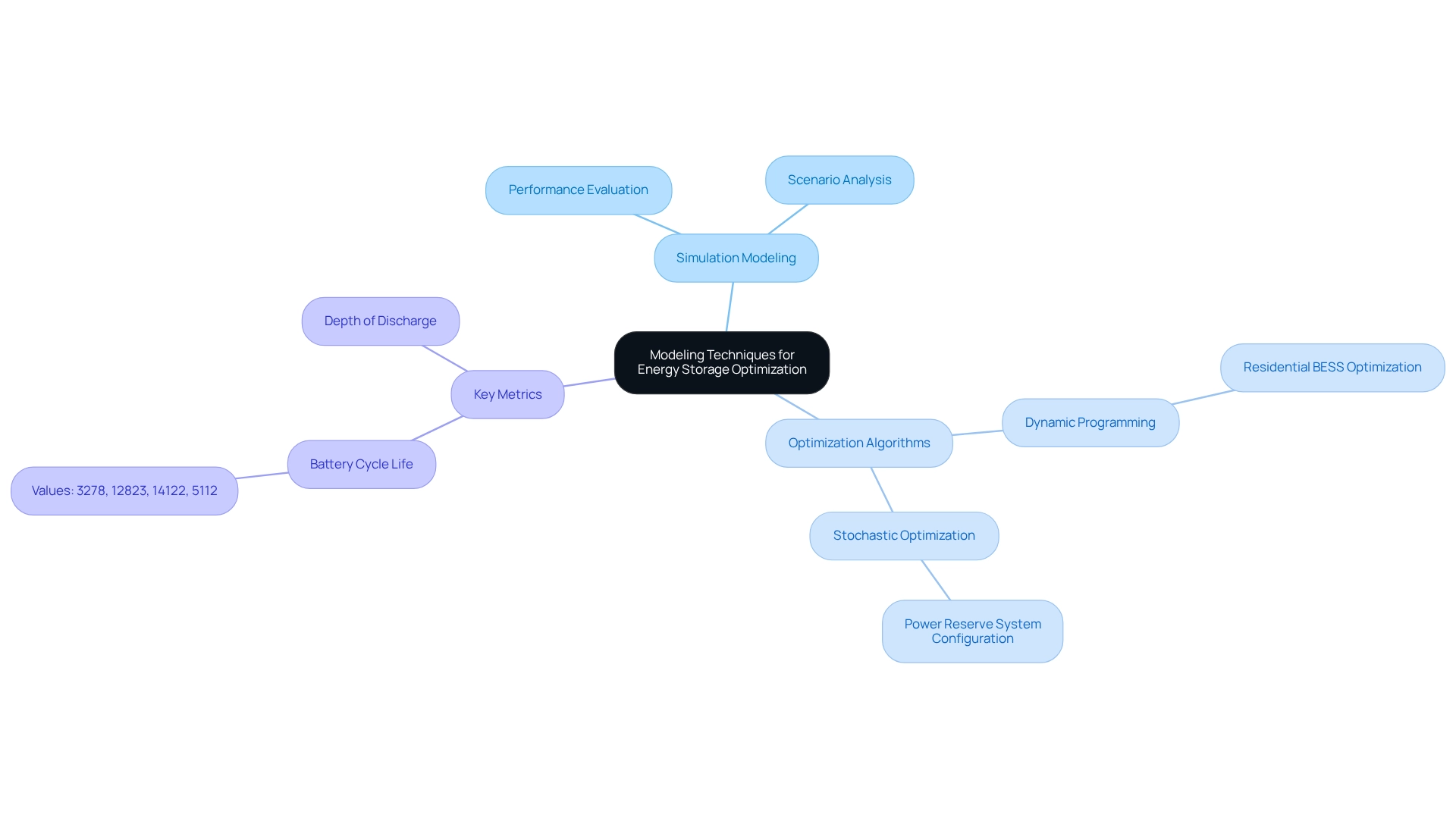
Grid-Scale Energy Storage Solutions: Supporting Large-Scale Renewable Deployment
Grid-scale power retention solutions are essential for facilitating the large-scale adoption of renewable energy + storage modeling as sustainable resource alternatives. These networks are designed to store substantial amounts of power generated from renewable sources, effectively balancing supply and demand on the grid. By acting as a buffer against fluctuations in power generation, grid-scale reserves enhance the reliability of renewable energy systems and accelerate the transition to a sustainable energy landscape.
Recent advancements in power retention technologies, such as thermochemical energy storage (TCES), showcase innovative methods for resource management. TCES systems harness solar energy through endothermic chemical reactions, allowing for efficient indirect heat storage and improving the performance of clean energy sources. This method also supports waste heat recovery, underscoring the multifaceted benefits of grid-scale solutions, particularly in boosting reliability and reducing costs.
The importance of grid-scale retention in 2025 cannot be overstated, as it plays a critical role in power supply management. With the increasing integration of renewable energy + storage modeling into the grid, effective retention solutions are vital for maintaining equilibrium between supply and demand. For instance, advanced hybrid power retention systems, such as those implemented in projects like the university campus in Saudi Arabia, demonstrate how grid-scale retention can significantly lower costs while enhancing power reliability.
Moreover, expert perspectives highlight the ongoing exploration of various retention technologies, including liquid air energy storage (LAES), which is gaining traction as a feasible solution for future energy needs. As Shaylin A. Cetegen, a PhD candidate in the MIT Department of Chemical Engineering, notes, "This is why the narrative of liquid air conservation is far from over." Our findings affirm the continued exploration of LAES as a pivotal power retention option for the future. As the energy landscape evolves, the impact of grid-scale reserves on supply management will remain a central focus for utilities and energy developers alike.
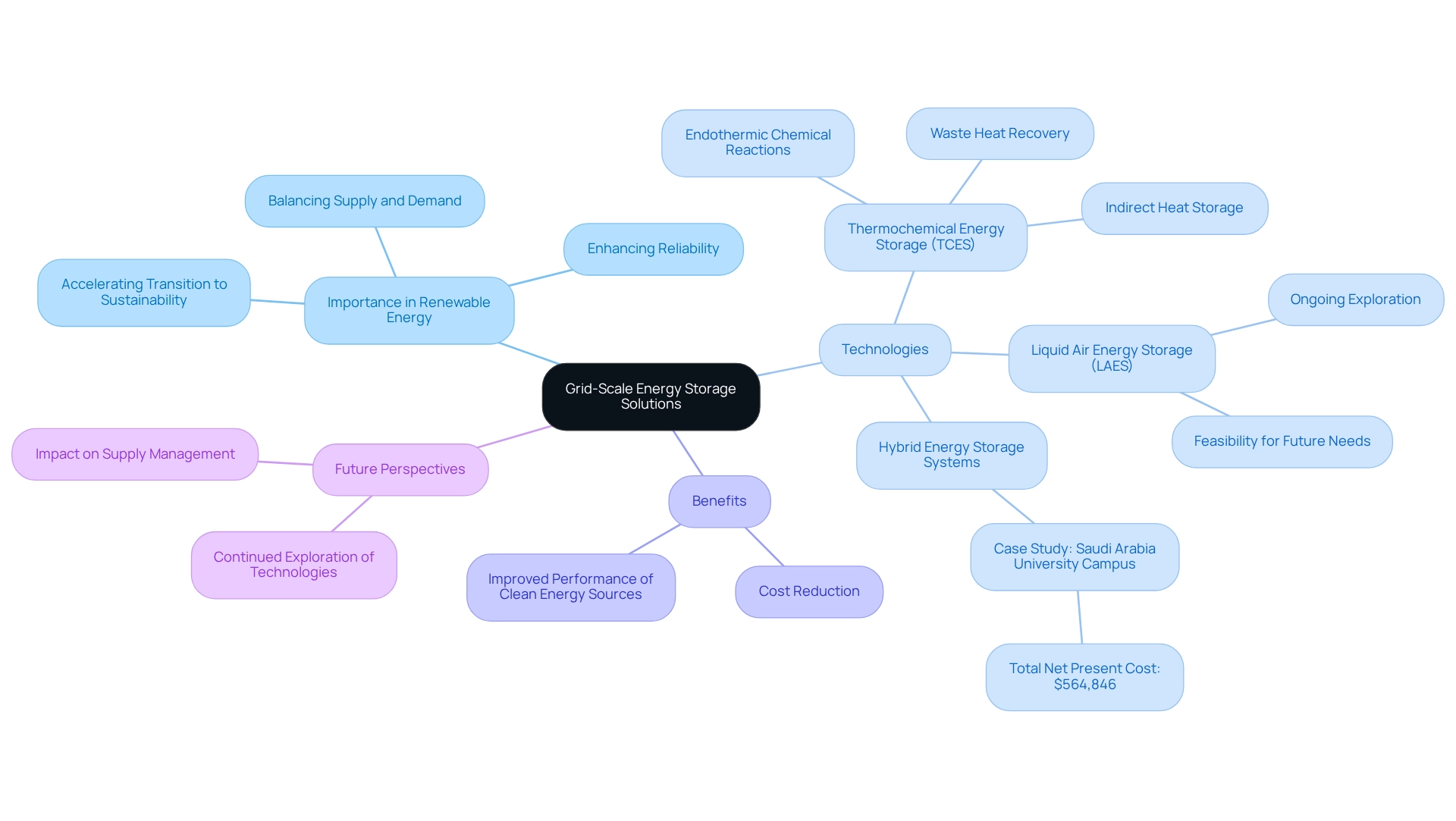
Economic Modeling for Energy Storage: Enhancing Investment Decisions in Renewables
Economic modeling for power retention is pivotal in enhancing investment choices within renewable energy + storage modeling projects. By conducting thorough cost-benefit analyses of various containment technologies, stakeholders can identify the most economically viable options, thereby optimizing their return on investment. Recent studies indicate that power retention solutions in tropical climates yield better returns than those in temperate areas, underscoring the significance of geographical factors in investment strategies. Furthermore, case studies, such as the financial modeling methods utilized in geothermal projects, illustrate how robust economic analysis can mitigate uncertainties in market conditions and project feasibility. These insights empower stakeholders to navigate the complexities of power reserve investments effectively.
As the sustainable power landscape evolves, understanding the impact of storage costs on project feasibility becomes increasingly crucial. The integration of sophisticated economic modeling and renewable energy + storage modeling not only aids in recognizing lucrative opportunities but also ensures that resources are allocated efficiently, fostering the sustainable development of alternative power systems. Financial analysts emphasize that informed investment choices, grounded in comprehensive economic evaluations, are essential for maximizing the potential of renewable energy + storage modeling projects in 2025 and beyond. Moreover, stakeholders must evaluate the risks associated with power reserve investments to make informed decisions.
As a practical tip, consider leveraging advanced economic modeling tools to refine your investment strategies and ensure optimal resource allocation.
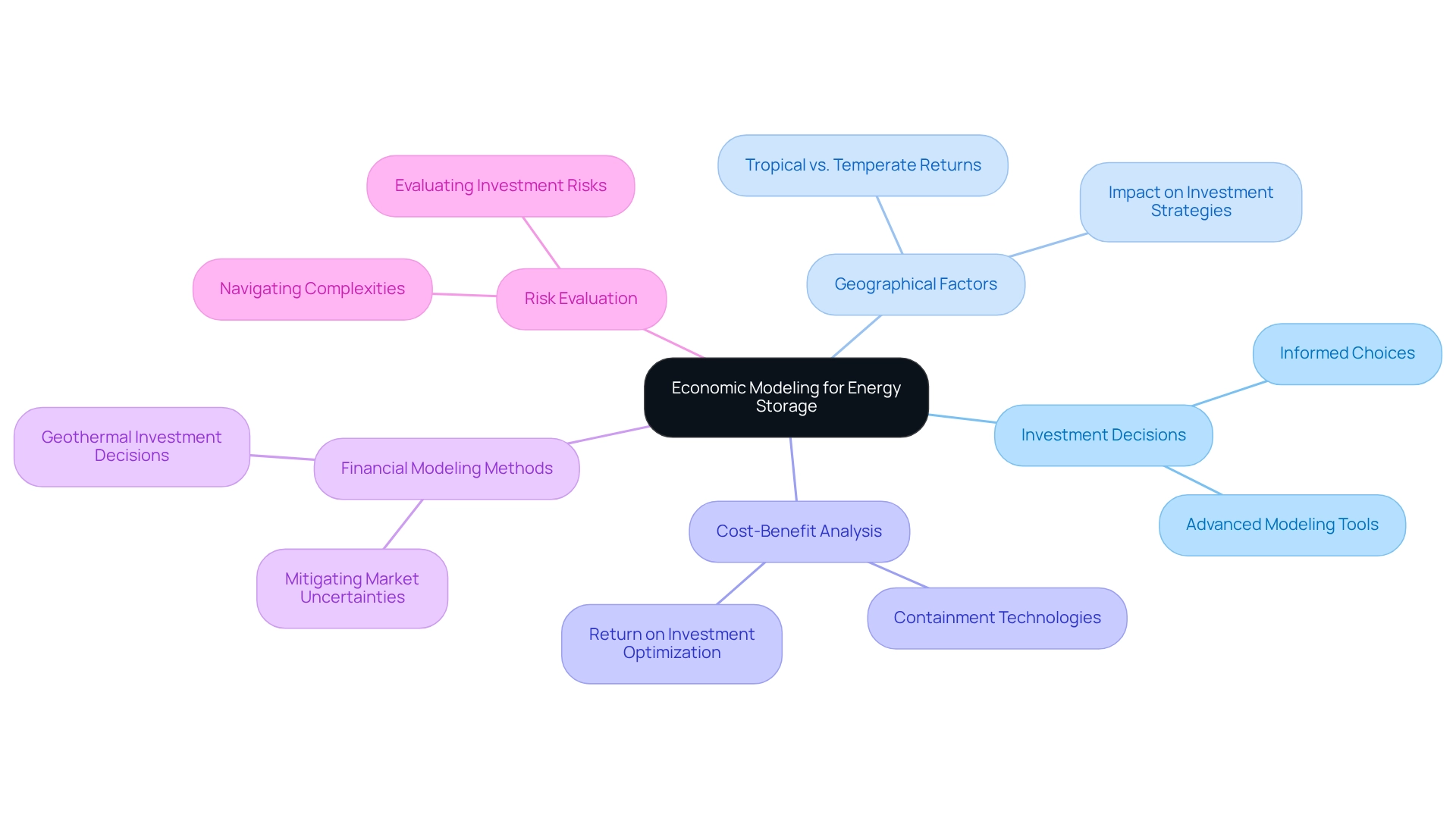
Policy Frameworks for Energy Storage: Shaping the Future of Renewable Energy
Policy frameworks play a pivotal role in shaping the trajectory of power retention and the adoption of renewable resources. By implementing targeted incentives, regulations, and support systems, policymakers can significantly influence the uptake of power retention technologies. For instance, Colorado's 2018 legislation, which grants utility customers the right to install power reserves, exemplifies how effective policy can streamline interconnection procedures and enhance accessibility for consumers. This legislative action not only facilitates smoother integration into the power system but also stimulates investment in renewable technologies.
Looking ahead, Texas aims to achieve an impressive 3,100 megawatts (MW) of storage capacity by 2035, underscoring the state's commitment to expanding its power infrastructure. Such ambitious targets highlight the importance of robust policy frameworks that enable project implementation and ownership, ultimately fostering a more resilient power grid. Harbinger Land, with its extensive land services and advanced GIS mapping capabilities, is strategically positioned to assist clients in navigating these regulatory landscapes, ensuring efficient site acquisition for power projects. Our team is equipped to provide tailored strategies addressing potential trade and permitting challenges, thereby maintaining project momentum.
As we approach 2025, the impact of regulations on the adoption of power retention technologies becomes increasingly evident. The Critical Raw Materials Act, for example, mandates EU member states to identify significant companies utilizing strategic raw materials by May 2025, reflecting a growing awareness of the necessity for sustainable resource management in technology. This act is crucial as it not only promotes the adoption of power retention solutions but also encourages innovation within the sector. Specialist insights suggest that these regulatory actions will significantly shape the future landscape of power retention.
Priscilla Barbour, State Policy in Texas, notes, "I think it’s starting to resonate more broadly just the impact the industry is having on construction and other industries that we use to develop these projects." This perspective underscores the interconnectedness of resource policy and its broader implications for various sectors, including land acquisition strategies. Harbinger Land's experienced team leverages AI-powered title research software to streamline these processes, ensuring clients can effectively respond to evolving policy demands.
In conclusion, effective policies are essential for advancing renewable energy + storage modeling solutions, creating an environment conducive to investment and innovation. As the landscape evolves, the interplay between regulations and technological advancement will be crucial in determining the future of power retention and its integration into the broader power ecosystem. To maximize the benefits of these developments, consider partnering with Harbinger Land to adeptly navigate the complexities of land acquisition and regulatory compliance.
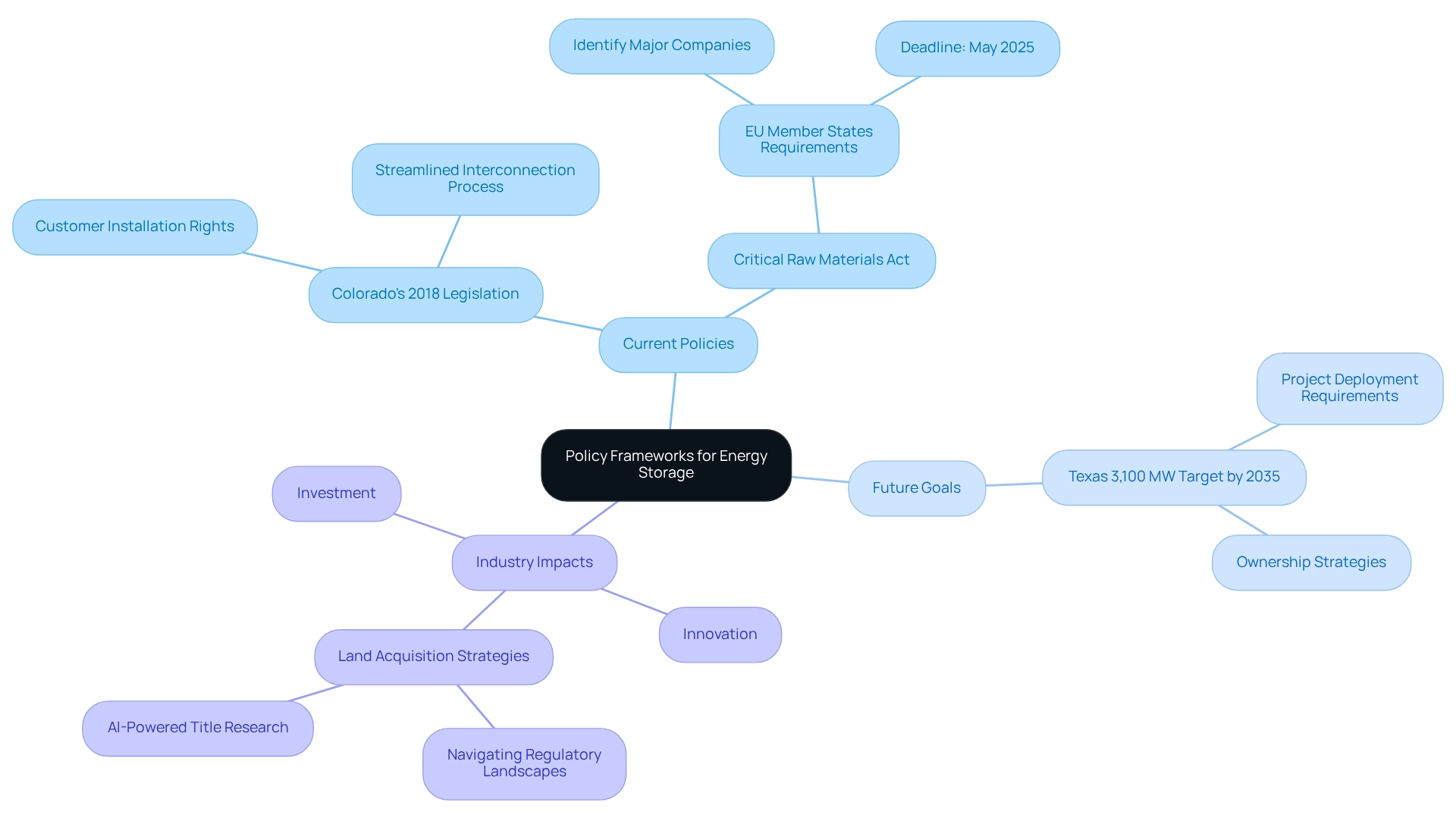
Future Trends in Energy Storage and Renewable Energy Integration: What to Expect
Upcoming trends in power retention and renewable energy + storage modeling are poised to be significantly influenced by technological advancements, cost reductions, and enhanced efficiency. Innovations such as solid-state batteries and AI-driven optimization tools are set to transform the sector. In 2024, grid management emerged as a critical application for power storage solutions, essential for stabilizing electrical grids and regulating electricity demand. These frameworks are increasingly recognized for their role in alleviating grid stress and preventing outages, underscoring their importance in modern power infrastructure.
As the demand for renewable energy escalates, the integration of sophisticated grid management systems will become imperative. Policymakers must carefully consider the trade-offs between local manufacturing costs—where the production of solar panels in the U.S. is three times more expensive than in China—and the benefits of job creation and security. This landscape will continue to evolve, with industry leaders emphasizing the necessity of innovative solutions to tackle future power challenges. Kathy Hitchens notes, "The advancements in sustainable power technology are not solely focused on efficiency; they aim to establish a lasting future that fulfills the requirements of our communities."
The ongoing advancements in power storage technology will not only enhance the efficiency of renewable energy + storage modeling initiatives but also contribute to a more sustainable and resilient future for energy. For directors of land acquisition, grasping these trends is vital for making informed decisions that align with the shifting energy landscape. Engaging with these developments can facilitate more effective project planning and execution, ensuring that services are timely and tailored to meet client needs.
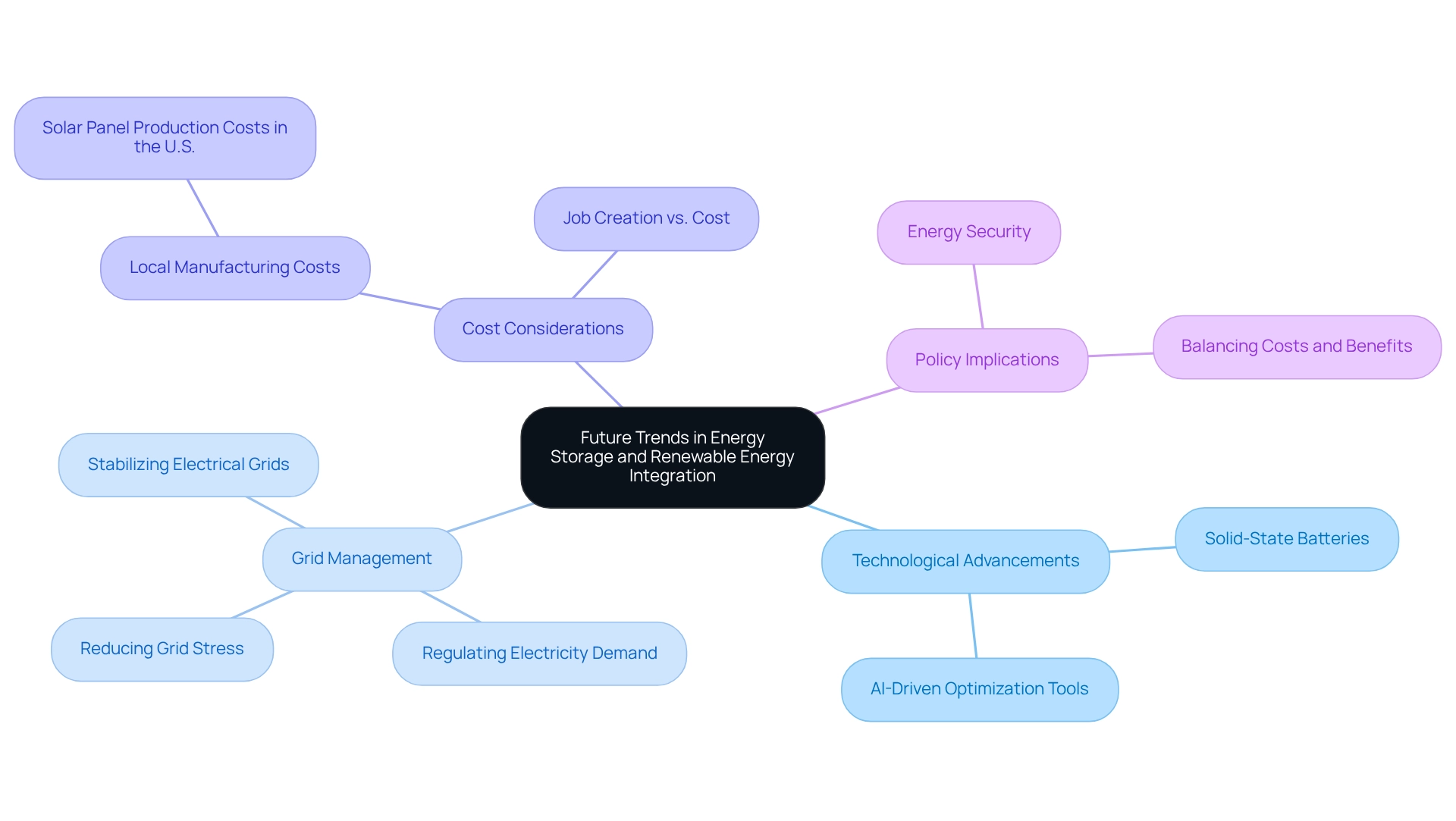
Conclusion
The renewable energy sector stands at a pivotal crossroads, where effective land acquisition and advanced energy storage solutions are essential for driving progress. Harbinger Land exemplifies the importance of strategic planning in land acquisition, utilizing innovative technologies like GIS modeling to streamline processes and ensure compliance with legal standards. As the demand for renewable energy grows, the significance of tailored land acquisition solutions becomes increasingly clear, facilitating expedited project timelines and enhancing stakeholder satisfaction.
Simultaneously, advancements in energy storage modeling are transforming the efficiency of renewable energy systems. By leveraging predictive capabilities and AI-driven technologies, stakeholders can optimize energy storage strategies, enabling seamless integration with renewable sources. The projected growth in energy storage markets underscores the necessity of these innovations, which are crucial for balancing supply and demand in an evolving energy landscape.
Moreover, integrating long-duration energy storage solutions addresses the intermittency challenges posed by renewable sources, ensuring a reliable energy supply. The exploration of innovative storage technologies, such as repurposed EV batteries and thermochemical energy storage, highlights the ongoing evolution in energy management strategies. As regulatory frameworks evolve, they will further shape the future of energy storage adoption, creating a conducive environment for investment and innovation.
In conclusion, the interplay between effective land acquisition, cutting-edge energy storage solutions, and supportive policy frameworks will play a critical role in shaping a sustainable energy future. As organizations like Harbinger Land navigate these complexities, they pave the way for successful project execution and a resilient energy infrastructure. Engaging with these advancements not only fosters operational efficiency but also contributes to the overarching goal of a more sustainable and reliable renewable energy ecosystem.
Frequently Asked Questions
What services does Harbinger Land provide for land acquisition?
Harbinger Land offers customized land acquisition solutions that include site and right-of-way acquisition, advanced GIS modeling for efficient easements, and document imaging solutions for digitizing property data.
How does Harbinger Land utilize GIS modeling in their services?
Harbinger Land uses advanced GIS modeling to create efficient easements, which helps save clients both time and money during the land acquisition process.
What is the importance of document imaging solutions in land acquisition?
Document imaging solutions allow Harbinger Land to digitize property data by sending imaging agents to courthouses or obtaining documents through records requests, facilitating cost-effective title research and leasing.
Why is effective land acquisition crucial for sustainable projects?
Effective land acquisition is essential as it ensures compliance with legal and regulatory standards, expedites project timelines, and improves stakeholder satisfaction in the evolving landscape of sustainable resources.
What does the case study 'Individual Responsibility in Sustainability' highlight?
The case study illustrates that every action contributes to broader sustainability objectives, emphasizing the critical role of land acquisition in sustainable projects.
How does Harbinger Land adapt to changing client needs?
Harbinger Land continuously adapts its solutions to meet the changing needs of clients, ensuring timely and precise services tailored to specific project requirements.
List of Sources
- Harbinger Land | Comprehensive Solutions for Land Acquisition in Renewable Energy Projects
- 20 Quotes To Get You Inspired For a Renewable Future - Solstice (https://solstice.us/solstice-blog/20-quotes-for-a-renewable-future)
- 60 Quotes About the Future of Renewable Energy (https://deliberatedirections.com/renewable-energy-quotes)
- 100+ inspirational and powerful quotes on Sustainability (clustered by topic) - Twenty Now (https://twentynow.com/sustainability-initiatives/sustainability/100-inspirational-and-powerful-quotes-on-sustainability-clustered-by-topic)
- Energy Storage Modeling: Enhancing Efficiency in Renewable Energy Systems
- Energy Storage Systems Market Size is Expanding US$ 569.39 Billion by 2034 (https://globenewswire.com/news-release/2025/04/07/3057015/0/en/Energy-Storage-Systems-Market-Size-is-Expanding-US-569-39-Billion-by-2034.html)
- thebusinessresearchcompany.com (https://thebusinessresearchcompany.com/report/renewable-energy-storage-global-market-report)
- AI-Powered Energy Storage Modeling: Transforming Renewable Energy Management
- AI Experts Speak: Memorable Quotes from Spectrum's AI Coverage (https://spectrum.ieee.org/artificial-intelligence-quotes/particle-4)
- intelliarts.com (https://intelliarts.com/blog/ai-in-renewable-energy-market-statistics)
- Long-Duration Energy Storage: Overcoming Challenges for Sustainable Energy Supply
- Clean Energy Storage Facts | ACP (https://cleanpower.org/facts/clean-energy-storage)
- Energy storage - IEA (https://iea.org/energy-system/electricity/grid-scale-storage)
- How long-duration batteries can power a cleaner, more reliable, and sustainable renewable energy future (https://unsw.edu.au/newsroom/news/2025/05/Long-duration-batteries-cleaner-reliable-sustainable-energy)
- Modeling Techniques for Optimizing Energy Storage Systems in Renewable Energy
- Smart optimization in battery energy storage systems: An overview (https://sciencedirect.com/science/article/pii/S2666546824000442)
- Stochastic Optimization Method for Energy Storage System Configuration Considering Self-Regulation of the State of Charge (https://mdpi.com/2071-1050/14/1/553)
- Grid-Scale Energy Storage Solutions: Supporting Large-Scale Renewable Deployment
- Powering America's Future: Grid-Scale Energy Storage Boosts Grid Reliability, Jobs, and U.S. Manufacturing (https://blog.fluenceenergy.com/powering-america-grid-scale-energy-storage-grid-reliability-jobs-manufacturing)
- Storage solutions for renewable energy: A review (https://sciencedirect.com/science/article/pii/S2772427125000324)
- Using liquid air for grid-scale energy storage (https://news.mit.edu/2025/using-liquid-air-grid-scale-energy-storage-0410)
- Economic Modeling for Energy Storage: Enhancing Investment Decisions in Renewables
- Profitability, risk, and financial modeling of energy storage in residential and large scale applications (https://sciencedirect.com/science/article/abs/pii/S0360544216318722)
- Policy Frameworks for Energy Storage: Shaping the Future of Renewable Energy
- Energy Storage Targets (https://climatepolicydashboard.org/policies/electricity/energy-storage-targets)
- Energy Storage Rides a Wave of Growth but Uncertainty Looms: A Global Opportunity and Regulatory Roadmap for 2025 (https://morganlewis.com/pubs/2025/03/energy-storage-rides-a-wave-of-growth-but-uncertainty-looms-a-global-opportunity-and-regulatory-roadmap-for-2025)
- morganlewis.com (https://morganlewis.com/pubs/2025/03/state-by-state-an-updated-roadmap-through-the-current-us-energy-storage-policy-landscape)
- SEIA Announces Target of 700 GWh of U.S. Energy Storage by 2030 – SEIA (https://seia.org/news/seia-announces-target-of-700-gwh-of-u-s-energy-storage-by-2030)
- Future Trends in Energy Storage and Renewable Energy Integration: What to Expect
- BESS Market Size & Growth: Trends Shaping the Energy Storage Landscape | PCI (https://pcienergysolutions.com/2024/12/06/bess-market-size-growth-trends-shaping-the-energy-storage-landscape)
- Energy Storage Systems Market Size is Expanding US$ 569.39 Billion by 2034 (https://globenewswire.com/news-release/2025/04/07/3057015/0/en/Energy-Storage-Systems-Market-Size-is-Expanding-US-569-39-Billion-by-2034.html)
- Massive global growth of renewables to 2030 is set to match entire power capacity of major economies today, moving world closer to tripling goal - News - IEA (https://iea.org/news/massive-global-growth-of-renewables-to-2030-is-set-to-match-entire-power-capacity-of-major-economies-today-moving-world-closer-to-tripling-goal)




